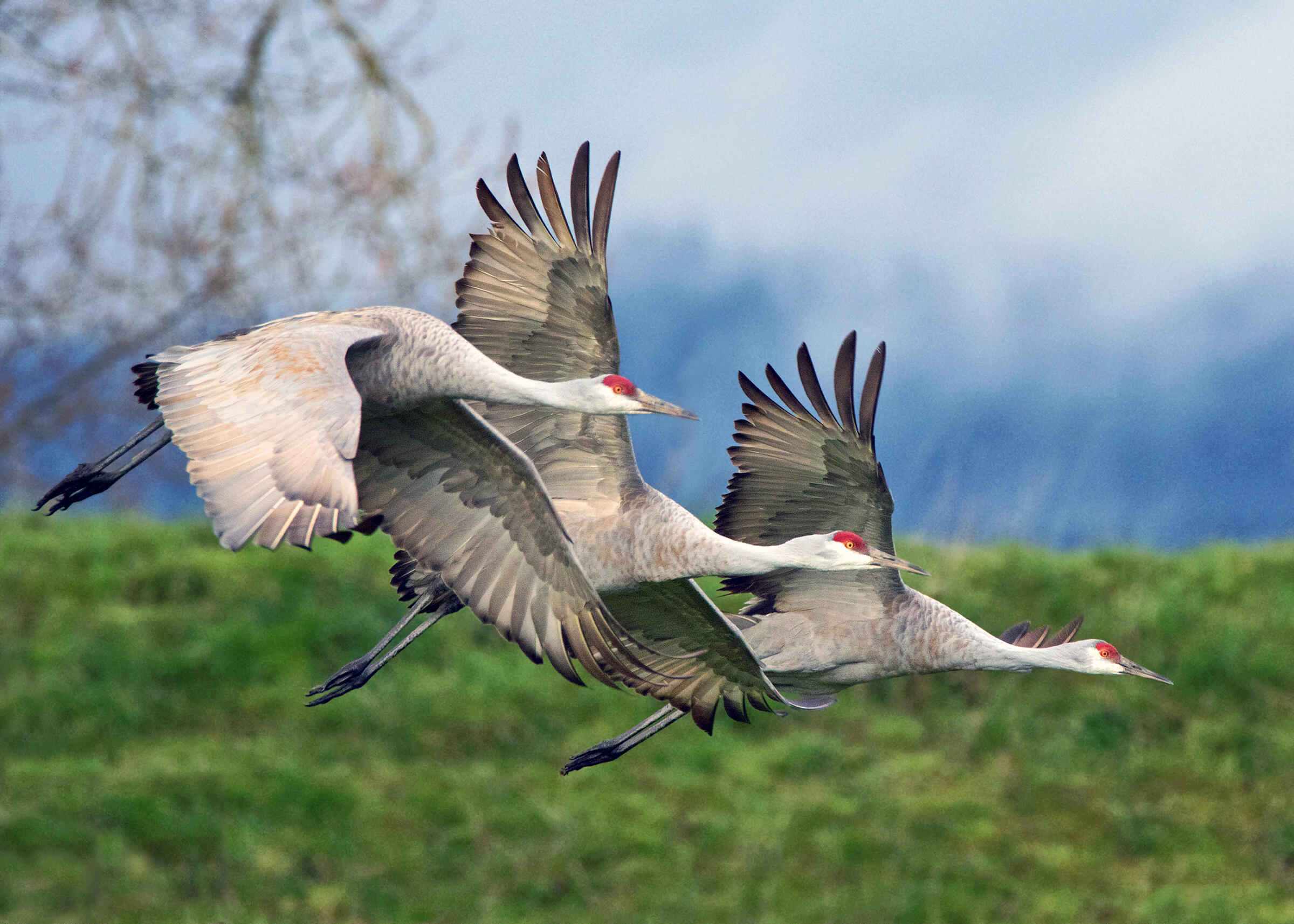Famous for their courtship dance, the Sandhill Crane is one the largest migrating North American cranes. Its wingspan can reach almost seven feet wide and it can be up to four feet tall. The width of the crane's wings make it a spectacular soaring bird that can be compared to raptors. It uses thermals in the sky to fly and can stay in the air with little flapping. The Sandhill Crane is an incredibly old species, a fossil found was 2.5 million years old, which is over one and a half times older than the earliest remains of most living species of birds.
Sandhill Cranes can be found near large freshwater marshes, prairie ponds, marshy tundra during summer and on grainfields or prairies during migration and in winter. Its range in the Pacific Flyway is from Siberia and Alaska to California's Central Valley. The mating dance of the Sandhill Crane is spectacular. Facing each other, members of a pair leap into the air with wings extended and feet thrown forward. Then they bow to each other and repeat the performance, uttering loud croaking calls. Courting birds also run about with their wings outstretched and toss tufts of grass in the air.
Greater Sandhill Cranes were once common breeders throughout the intermountain west, wintering primarily in the Central Valley of California. However, their populations declined drastically as a result of unregulated hunting and habitat loss during settlement of the region. They became extinct as a breeder in Washington by 1941, when there were only an estimated 150-200 pairs remaining in Oregon. In California, the breeding population was reduced to fewer than five pairs by the 1940s. Fortunately, all populations of Greater Sandhill Cranes have increased since the 1940s, and in 2000 an estimated 465 pairs were breeding in California. Nonetheless, much of their historic range remains vacant and the population remains far below historic numbers.
California in particular is special in that it supports the Central Valley population of Greater Sandhill Cranes that winters in suitable agricultural fields and wetlands of the Central Valley and breeds in northeastern California, as well as parts of Nevada, Oregon, Washington, and British Columbia, mostly on private lands. The Central Valley population of Greater Sandhill Cranes remains low, with recovery of the population hindered by the lack of directed conservation, despite the potential for habitat restoration and farmland management that could greatly benefit this population.
Audubon California’s Working Lands Program has dramatically expanded its work with farmers and ranchers across California over the last five years, providing a significant opportunity to work closely with farmers and ranchers to create and manage habitats that will protect crane populations both on their breeding and wintering grounds. Since 2008, Audubon helped secure two conservation easements in northeastern California to protect ranches with irrigated pastures that support Greater Sandhill Cranes. As part of the Migratory Bird Conservation Partnership, Audubon has an opportunity to take specific action targeting Sandhill Crane conservation in the Valley. Working with these partners, Audubon is increasing the amount of farmland in the Central Valley that is managed specifically for Sandhill Cranes.
Top 4 Places to Visit Sandhill Cranes
Merced National Wildlife Refuge
The Merced NWR hosts the largest wintering concentration of Lesser Sandhill Cranes in the Pacific Flyway. Over 15,000 Sandhill cranes are in the Grasslands by Thanksgiving. Groundwater pumped into the Merced Refuge provides much-needed habitat for ducks, geese, cranes, shorebirds, and other wildlife each winter. We saw 40 species during our late afternoon visit, including dozens of greater white-fronted geese, white-faced ibis, pintails, shovelers, black-necked stilts, dunlin, and dowitchers. Come witness just how important the Central Valley refuge system is for migratory birds. Visit Merced NWR
Staten Island
Located in the heart of the Sacramento-San Joaquin River Delta, Staten is 9,200 acres located between the North and South Forks of the Mokelumne River. Staten Island has been a wintering destination for Sandhill Cranes moving along the Pacific Flyway for more than 40 years. The Nature Conservancy acquired the Island in 2001 to protect its important role as a place for wildlife-friendly agriculture to support conservation along the flyway. Staten Island’s assortment of crops provides both foraging and roosting habitat across the fall and winter seasons for wintering cranes. Important crops are corn, triticale, potatoes, alfalfa, and irrigated pasture. Visit Staten Island
Pixley National Wildlife Refuge
Thousands of wintering Sandhill Cranes utilize the refuge from late September through late February. The majority of the Sandhill Crane that winter at Pixley NWR come from as far as Homer, Alaska. The foot trail at Pixley NWR is open from sunrise to sunset. The observation deck at the end of the foot trail is the best vantage point to view large numbers of Sandhill Crane as they fly off and onto the refuge, as they forage and roost. Bring a flashlight, sturdy comfortable shoes, and layers. Visit Pixley
Cosumnes River Preserve
At this location, there is excellent viewing by car. Drive west of Franklin Blvd., along Desmond Road, and beside Bruceville Road (just south of Twin Cities Rd.). The best chance to see the cranes is during the day while the cranes feed on the fields. You may pull off to the side of the road, but do not walk onto the levee. This will scare the birds. Viewing is best done from your car. Visit Cosumnes River Preserve
How you can help, right now
Get Audubon CA in Your Inbox
Our newsletter is fun way to get our latest stories and important conservation updates from across the state.
Donate to Audubon
Help secure the future for birds at risk from climate change, habitat loss and other threats. Your support will power our science, education, advocacy and on-the-ground conservation efforts.
HOTSPOT: Flyover of California's Birds and Biodiversity
California is a global biodiversity hotspots, with one of the greatest concentrations of living species on Earth.







